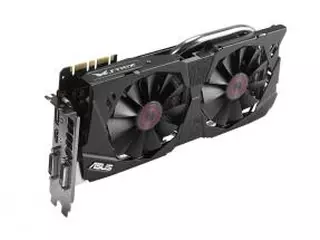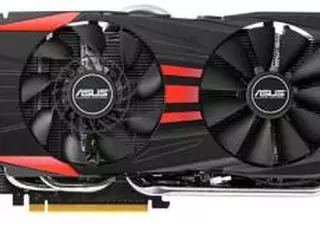GeForce GTX 970 vs Radeon R9 280
Find out if it is worth upgrading your current GPU setup by comparing GeForce GTX 970 and Radeon R9 280. Here you can take a closer look at graphics cards specs, such as core clock speed, memory type and size, display connectors, etc. The price, overall benchmark and gaming performances are usually defining factors when it comes to choosing between GeForce GTX 970 and Radeon R9 280. Make sure that the graphics card has compatible dimensions and will properly fit in your new or current computer case. Also these graphics cards may have different system power recommendations, so take that into consideration and upgrade your PSU if necessary.
Main Specs
GeForce GTX 970
Radeon R9 280
Power consumption (TDP)
148 Watt
200 Watt
Interface
PCIe 3.0 x16
PCIe 3.0 x16
Supplementary power connectors
2x 6-pins
1 x 6-pin + 1 x 8-pin
Memory type
GDDR5
GDDR5
Maximum RAM amount
4 GB
3 GB
Display Connectors
1x DVI, 1x HDMI, 3x DisplayPort
2x DVI, 1x HDMI, 2x mini-DisplayPort
Recommended system power (PSU)
500 Watt
Check Price
Check Price
Radeon R9 280 has 35% more power consumption, than GeForce GTX 970.
Both video cards are using PCIe 3.0 x16 interface connection to a motherboard.
GeForce GTX 970 has 1 GB more memory, than Radeon R9 280.
Both cards are used in Desktops.
GeForce GTX 970 is build with Maxwell architecture, and Radeon R9 280 - with GCN 1.0.
GeForce GTX 970 and Radeon R9 280 are manufactured by 28 nm process technology.
Radeon R9 280 is 265 mm longer, than GeForce GTX 970.
Memory clock speed of Radeon R9 280 is 1243 MHz higher, than GeForce GTX 970.
Game benchmarks
Assassin's Creed Odyssey
Battlefield 5
Call of Duty: Warzone
Counter-Strike: Global Offensive
Cyberpunk 2077
Dota 2
Far Cry 5
Fortnite
Forza Horizon 4
Grand Theft Auto V
Metro Exodus
Minecraft
PLAYERUNKNOWN'S BATTLEGROUNDS
Red Dead Redemption 2
The Witcher 3: Wild Hunt
World of Tanks
high / 1080p
50−55
35−40
ultra / 1080p
30−35
21−24
QHD / 1440p
27−30
16−18
4K / 2160p
14−16
10−11
low / 720p
75−80
60−65
medium / 1080p
60−65
40−45
The average gaming FPS of GeForce GTX 970 in Assassin's Creed Odyssey is 37% more, than Radeon R9 280.
high / 1080p
75−80
55−60
ultra / 1080p
70−75
45−50
QHD / 1440p
50−55
35−40
4K / 2160p
27−30
18−20
low / 720p
130−140
100−110
medium / 1080p
85−90
60−65
The average gaming FPS of GeForce GTX 970 in Battlefield 5 is 38% more, than Radeon R9 280.
low / 768p
45−50
50−55
QHD / 1440p
45−50
0−1
The average gaming FPS of Radeon R9 280 in Call of Duty: Warzone is 10% more, than GeForce GTX 970.
low / 768p
250−260
250−260
medium / 768p
230−240
220−230
ultra / 1080p
−
180−190
QHD / 1440p
150−160
110−120
4K / 2160p
100−110
70−75
high / 768p
220−230
210−220
The average gaming FPS of GeForce GTX 970 in Counter-Strike: Global Offensive is 10% more, than Radeon R9 280.
low / 768p
70−75
60−65
medium / 1080p
50−55
55−60
The average gaming FPS of GeForce GTX 970 in Cyberpunk 2077 is 3% more, than Radeon R9 280.
low / 768p
120−130
120−130
medium / 768p
110−120
110−120
ultra / 1080p
110−120
100−110
The average gaming FPS of GeForce GTX 970 in Dota 2 is 2% more, than Radeon R9 280.
high / 1080p
60−65
45−50
ultra / 1080p
60−65
40−45
QHD / 1440p
40−45
27−30
4K / 2160p
21−24
14−16
low / 720p
100−110
80−85
medium / 1080p
65−70
45−50
The average gaming FPS of GeForce GTX 970 in Far Cry 5 is 39% more, than Radeon R9 280.
high / 1080p
90−95
60−65
ultra / 1080p
70−75
45−50
QHD / 1440p
45−50
27−30
4K / 2160p
21−24
27−30
low / 720p
220−230
180−190
medium / 1080p
140−150
110−120
The average gaming FPS of GeForce GTX 970 in Fortnite is 29% more, than Radeon R9 280.
high / 1080p
85−90
60−65
ultra / 1080p
65−70
45−50
QHD / 1440p
45−50
30−35
4K / 2160p
30−35
24−27
low / 720p
130−140
100−110
medium / 1080p
90−95
65−70
The average gaming FPS of GeForce GTX 970 in Forza Horizon 4 is 37% more, than Radeon R9 280.
low / 768p
160−170
140−150
medium / 768p
150−160
120−130
high / 1080p
95−100
70−75
ultra / 1080p
45−50
30−35
QHD / 1440p
40−45
21−24
The average gaming FPS of GeForce GTX 970 in Grand Theft Auto V is 27% more, than Radeon R9 280.
high / 1080p
35−40
24−27
ultra / 1080p
30−35
20−22
QHD / 1440p
24−27
16−18
4K / 2160p
14−16
8−9
low / 720p
95−100
65−70
medium / 1080p
50−55
30−35
The average gaming FPS of GeForce GTX 970 in Metro Exodus is 53% more, than Radeon R9 280.
low / 768p
120−130
130−140
medium / 1080p
−
120−130
The average gaming FPS of Radeon R9 280 in Minecraft is 8% more, than GeForce GTX 970.
high / 1080p
75−80
−
ultra / 1080p
55−60
14−16
4K / 2160p
18−20
−
low / 720p
120−130
100−110
medium / 1080p
85−90
18−20
The average gaming FPS of GeForce GTX 970 in PLAYERUNKNOWN'S BATTLEGROUNDS is 95% more, than Radeon R9 280.
high / 1080p
35−40
24−27
ultra / 1080p
24−27
16−18
QHD / 1440p
16−18
10−11
4K / 2160p
10−12
7−8
low / 720p
90−95
65−70
medium / 1080p
55−60
35−40
The average gaming FPS of GeForce GTX 970 in Red Dead Redemption 2 is 48% more, than Radeon R9 280.
low / 768p
180−190
130−140
medium / 768p
120−130
85−90
high / 1080p
70−75
45−50
ultra / 1080p
40−45
24−27
4K / 2160p
24−27
16−18
The average gaming FPS of GeForce GTX 970 in The Witcher 3: Wild Hunt is 45% more, than Radeon R9 280.
low / 768p
120−130
90−95
medium / 768p
−
60−65
ultra / 1080p
65−70
50−55
high / 768p
−
60−65
The average gaming FPS of GeForce GTX 970 in World of Tanks is 33% more, than Radeon R9 280.
Full Specs
GeForce GTX 970
Radeon R9 280
Architecture
Maxwell
GCN 1.0
Code name
GM204
Tahiti
Type
Desktop
Desktop
Release date
19 September 2014
4 March 2014
Pipelines
1664
1792
Core clock speed
1050 MHz
Boost Clock
1178 MHz
933 MHz
Transistor count
5,200 million
4,313 million
Manufacturing process technology
28 nm
28 nm
Texture fill rate
109 billion/sec
104.5
Floating-point performance
3,920 gflops
3,344 gflops
Length
10.5" (26.7 cm)
275 mm
Memory bus width
256 Bit
384 Bit
Memory clock speed
7.0 GB/s
1250 MHz
Memory bandwidth
224 GB/s
240 GB/s
Shared memory
-
G-SYNC support
+
DirectX
12 (12_1)
Shader Model
6.4
5.1
OpenGL
4.4
4.6
OpenCL
1.2
1.2
Vulkan
1.1.126
+
CUDA
+
Monero / XMR (CryptoNight)
0.48 kh/s
FreeSync
+
CUDA cores
1664
Bus support
PCI Express 3.0
PCIe 3.0
Height
4.376" (11.1 cm)
SLI options
+
Multi monitor support
4 displays
HDMI
+
HDCP
+
Maximum VGA resolution
2048x1536
Audio input for HDMI
Internal
Bitcoin / BTC (SHA256)
478 Mh/s
408 Mh/s
Eyefinity
+
HD3D
+
TrueAudio
+
Design
reference
CrossFire
+
DDMA audio
+
Decred / DCR (Decred)
1.51 Gh/s
Ethereum / ETH (DaggerHashimoto)
22.21 Mh/s
21.5 Mh/s
Zcash / ZEC (Equihash)
291.61 Sol/s
GameStream
+
GeForce ShadowPlay
+
GPU Boost
2.0
GameWorks
+
LiquidVR
+
TressFX
+
UVD
+
Check Price
Check Price

